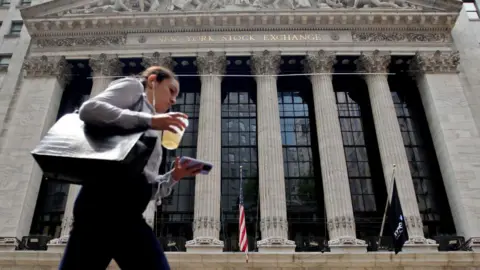 Getty Images
Getty ImagesThe US central bank lowered interest rates for the first time in four years on Wednesday.
The much anticipated move will influence mortgages, credit card and saving rates for millions of people in the US – and even around the world.
The Federal Reserve reduced the key lending rate by half a percentage point, to a range of 4.75% to 5%.
So what does this mean for you?
What does a cut mean for mortgages, car loans, and other debt?
The Fed’s key lending rate – what it charges banks to borrow – sets a base for what companies charge people in the US for loans, like mortgages, or other debt, like unpaid credit card balances.
That rate has hovered around 5.3% for more than a year, the highest level since 2001, since jumping from near zero at the start of 2022.
A cut will bring some welcome relief to borrowers, though it will likely mean that some banks knock down the rates they are offering savers too.
Mortgage rates in the US have already dropped a bit, partially in anticipation of the move.
What could the global impact be?
 Getty Images
Getty ImagesAmericans will be most directly affected by a change. But central banks with currencies tied to the dollar often link their rate decisions to the Fed, such as Hong Kong and many Gulf states, so borrowers in those countries will also see an impact.
For the many people outside of the US invested in the US stock market, a cut is also likely good news.
Lower interest rates tend to boost stock prices for two reasons.
First, it means companies can borrow debt for less money and reinvest it to make the business more profitable.
Second, lower rates mean savings accounts and some other kinds of investments become less attractive, so investors tend to move their money towards things like stocks.
Why did the Fed cut rates?
Compared to other central banks, the Fed is a bit late to the rate-cutting party.
Europe, the UK, New Zealand, and Canada have cut rates already, and so have many banks in emerging markets.
As for the Fed, it cuts or raises rates in response to two factors: inflation and employment.
In 2022, when the Fed started raising interest rates, officials were focussed on inflation and wanted to get consumer prices, then rising at the fastest pace since the 1980s, to stabilise.
A jump in rates tends to bring down prices by making it harder to borrow, so people spend less on everything from consumer goods to homes and business equipment.
But less demand also means the economy isn’t growing as quickly, and if it slows too much and actually starts contracting then that’s a recession.
In the past, the US economy has often entered recession after a series of rate hikes, costing millions of people their jobs.
And over the last year, unemployment in the US has been ticking higher, as hiring slows sharply.
So did the Fed cut rates because it triumphed in its fight against inflation or because the economy is in peril?
Many analysts maintain it’s the former. Price inflation hit 2.5% in August.
Officials have said they’re increasingly confident inflation is headed back to normal, so their attention is turning to the risks to the job market.
One factor officials have insisted does not inform into their decision is the election.
Republicans and Democrats have been watching this Fed’s moves closely for two years, and a cut will likely help Democrats as the party in power.
But Fed chair Jerome Powell has said time and again that the bank is focused on economic data, not politics, in making its move.
Was the 0.5 percentage point cut a surprise?
 Getty Images
Getty ImagesThe move was certainly unexpected.
Ahead of the meeting, analysts were divided about whether the Fed would announce a cut of 0.25 percentage points or go for a bigger, and more unusual, 0.5 percentage points cut.
Most believed a 0.25 percentage points cut was most likely, but that did not happen.
For a bank that has tried hard to telegraph its moves well in advance, the level of uncertainty was unusually high.
